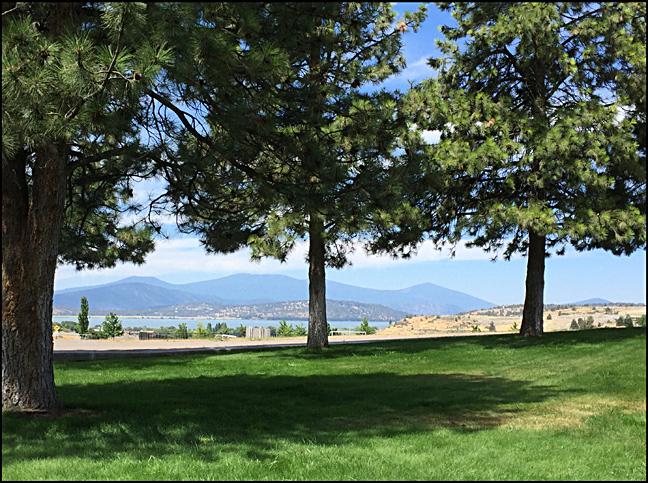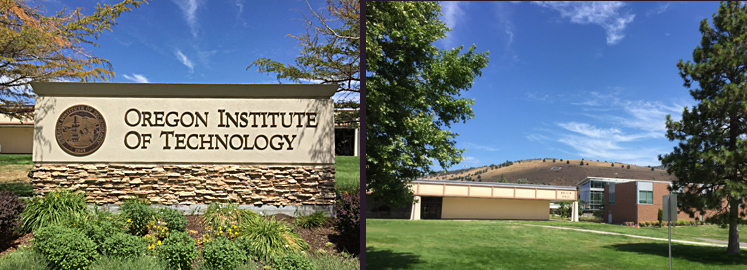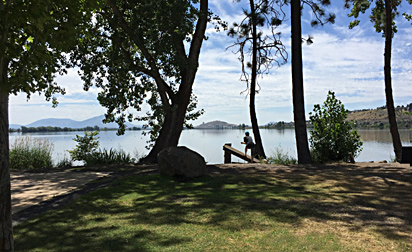

Here is a view of the Klamath Falls area that I think encapsulates the charms and distinctive character of region. We are at almost 4,400 ft. elevation and standing on the green lawns of OIT, a four year college. Ponderosa pines frame the view, but on the adjacent hillsides, we see a more bare sagebrush and juniper aspect. And we are on a hill, Klamath Falls as a city is definitely not flat and boring in that respect. In the distance rises the eastern flank of the Cascade Mountains, spread out aross this view is the Mountain Lakes Wild Area (link), a conglomeration of four extinct shield volcanoes which still sport glaciated peaks like Aspen Pk. and Mt. Harriman which approach or exceed 8000 ft. For the majority of every year they are cloaked with snow. And in the middle ground, you see part of Klamath Lake, a nationally-famed bird flyway that is 63,000 acres in size. It's but a tiny remanent of the Ice Age Lake Modoc, which was some ten times its size... (OIT = Oregon Institute of Technology with 3 degree programs, including a few to the Master's level. Its campus is also the only college campus in the United States to be completely heated by geo-thermal energy, and in 2014 it became the first college to be powered by 100% onsite electricity, provided by both solar and geothermal sources!)

Down at the city park beside the lake, one is shocked to find Pelicans and seagulls 130 mountainous (air) miles inland, and thriving in a semi-desert steppe climate with plenty of snow in the winter. The north end of the lake features Upper Klamath National Wildlife Refuge near Rocky Point, while south of the city is the Lower Klamath NWR.

Sky Lakes Medical Center, whose expansive campus has probably the best views of any hospital in Oregon, featuring 14,162 ft. Mt. Shasta to the southwest, and the Mountain Lakes Wild Area to the northwest, as well as views of the city and Klamath Lake below. The hospital of couse has a Helipad and full medical speciality services.
AIRPLANES: Klamath was homebase to an Air Force base until 1978, that being Kingsley Field, which was transferred to the Oregon National Guard and is now home of the 173rd Fighter Wing of the Air National Guard, and also home to a Flight Surgeon school.... History: the airport was home to NAS Klamath Falls in WW II (Naval Air Station). This discussion brings up the long and troubled history of the commericial use of the airfield, which as of 2017 may have ceased entirely. Of course, plenty of private planes come in and out of the airfield and its two runways.
RAILROAD: Another feature that make Klamath Falls a full-featured city is that Amtrak has a major station there (unlike Bend, Burns or Lakeview).... So KFalls is not as isolated as it would seem from its location in southeastern Oregon's high desert. If one wanted to make a long day of it, they could hop on the early morning Amtrak north, and spend the day in big city liberal college town Eugene, then come back on the late evening train. Or, one could go south, arriving in the the Bay Area within one day of travel on the comfortable train.
Climatologically, Klamath Falls has good claim on the title of the sunniest full-featured city in Oregon. This is on an annualized basis, averaging all the winter, summer, spring and fall months together. In certain seasons, other cities may prevail, for example, summer, when boiling-hot Medford is probably a bit sunnier because in the summer KFalls can receive more thunderstorm action than Medford.
Environmental Concerns: here's a major one, taken from the Oregon Wild website: "Unfortunately, the natural resources of this unique, natural basin has suffered through decades of abuse and mismanagement.
"A massive federal irrigation project drained 80 percent of the region's wetlands, collapsing the area's once-mighty fish runs. A series of aging dams on the Klamath River continue to block salmon and steelhead from reaching over 300 miles of historic habitat, and in September of 2002, the Klamath suffered one of the worst fish kills in U.S. history.
"For nearly two decades Oregon Wild has been a leading voice for conservation to this important region, working to bring resource demands back into balance with what the basin can naturally provide Here is some relevant history of the Klamath Basin (source Wikipedia):
"Half a century ago, during the peak of fall migration, over 7 million waterfowl and 1000 overwintering bald eagles could be found in the Klamath Basin at one time. [the Klamath Basin is a key location on the Pacific Flyway]
"Home to invaluable wildlife species and remarkable territory, the basin wetlands drew the attention of conservationists from across the nation, including President Theodore Roosevelt. In 1908 President Roosevelt designated 81,000 acres of marsh and open water in Lower Klamath Lake as the first National Wildlife Refuge for waterfowl. Twenty years later, Tule Lake joined the Refuge System when President Calvin Coolidge authorized the protection of 37,000 acres in what was Tule Lake."
Creative Writing: copyright Bruce Johnson, 2017-2021.
DEATH BY STEREOTYPE
It was hot and sunny, exactly what we’d expected in the eastern Oregon desert town of Klamath Falls. But our Yorkie needed a bathroom break so we were delighted to find Veterans Memorial Park and its pretty lake teeming with gulls and pelicans. What happened next nearly thrust us into being unwitting accomplices in a man’s death.
As we exited our car, a duo of apparently homeless men shouted
at us in a hostile way to keep the heck away from their shady
corner of the big park. We pivoted 180 degrees and headed toward
the lake when suddenly a thin older man with a scraggly beard,
sprawled half-upright on the grass, called to us. My wife walked
past the man, thinking he was another homeless person with an
unwelcome agenda. In front of him was what appeared to be a King
Charles Spaniel, the same lovable dog breed my brother owns.
My eyes took in the scene: the well-groomed dog contrasted with
his owner’s disheveled clothing.
”Help me.” The man’s ragged words were soft as
he held out his right hand like a beggar. I noticed a small green
oxygen bottle, the kind my father had used in his later years,
lying in the grass before him. The man gestured weakly, “Go
to my van… there’s an oxygen bottle, it’s behind
the seat.” His later model SUV was only 60-70 feet away but
he’d collapsed, unable to cover the final distance.
Noticing I’d stopped, my wife turned back and recognized
the medical emergency. Grabbing the keys from his outstretched
hand, she threw them toward me as I raced toward the SUV. I snatched
the oxygen bottle from the pocket behind the passenger seat and
ran it to his side, praying he’d be able to operate it before
losing consciousness.
But he quickly connected the oxygen tubing and almost immediately
began to breathe easier, even sitting up after a few moments.
As he generously thanked us it occurred to me that perhaps we
had saved a life that day in that city park, hundreds of miles
from home.
But it was also sobering: we’d fallen prey to a stereotype
about the homeless which could have easily cost a man his life.
In a way, his dog had saved him by rendering him less “threatening”
to me, that I could pause long enough to hear his words.
Bruce Johnson
July 2017